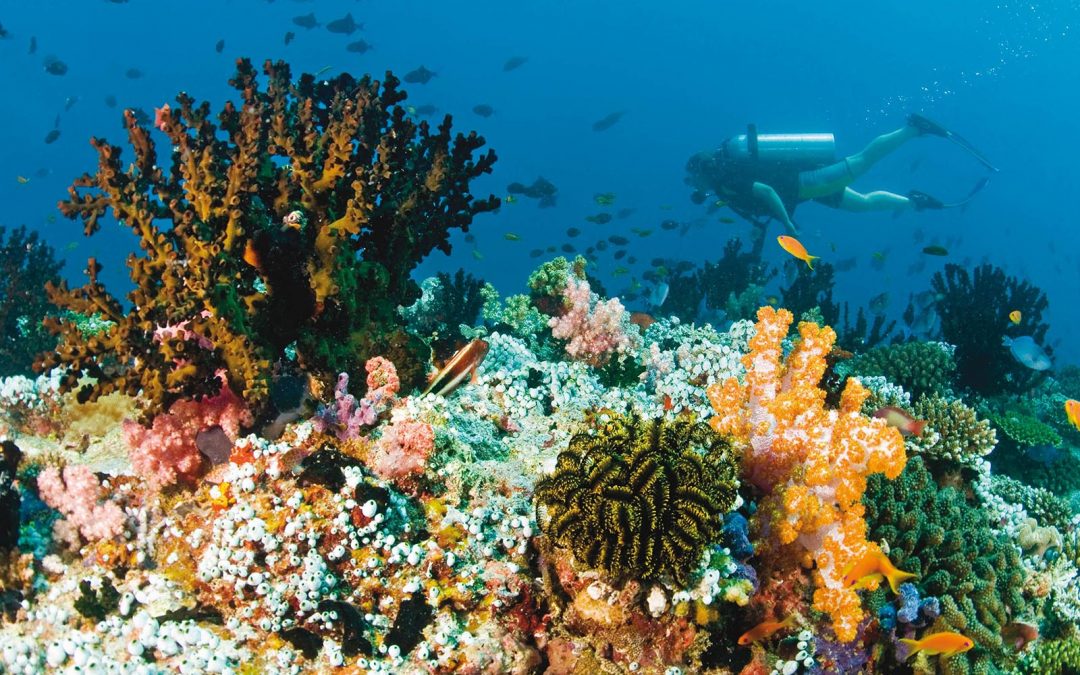In the previous blog, we mentioned about two coral reefs namely the Great Barrier Reef in Australia and the Raja Ampat in Indonesia which have been affected by shipping. In this blog we will be informing you about two more Coral Reefs which have been affected by shipping. These are The Red Sea Coral Reef and the Coral Reefs of Maldives.
The Red Sea Coral Reef – Situated amidst the world’s hottest and driest deserts, the Sahara and the Arabian desert, the Red Sea Coral reefs along the coasts of Egypt, Djibouti, and Israel are one of the oldest. As per scientists, they formed five to seven thousand years ago and are resilient in nature, capable of withstanding temperature changes, occasional turbidity and salinity, making them different from other reef systems.
They were formed due to the active tectonic forces, which continue to this day. The Red Sea coral reef spans 1200 miles and comprises 300 species of hard coral and 1200 fish species, of which 10% are endemic to the area and depend on corals. This coral reef is unlike any other and holds a unique charm.
Most coral reefs occur in shallow water near shore. As a result, they are particularly vulnerable to the effects of human activities, both through direct exploitation of reef resources, and through indirect impacts from adjacent human activities on land and in the coastal zone. Many of the human activities that degrade coral reefs are inextricably woven into the social, cultural, and economic fabric of regional coastal communities.
Coral reefs face many threats from local sources, including:
- Physical damage or destruction from coastal development, dredging, destructive fishing practices and gear, boat anchors and groundings.
- Pollution that originates on land but finds its way into coastal waters. There are many types and sources of pollution from land-based activities.
- Sedimentation from coastal development, urban storm-water runoff, forestry, and agriculture. Sedimentation has been identified as a primary stressor for the existence and recovery of coral species and their habitats. Sediment deposited onto reefs can smother corals and interfere with their ability to feed, grow, and reproduce.
- Nutrients (nitrogen and phosphorous) from agricultural and residential fertilizer use, sewage discharges (including wastewater treatment plants and septic systems), and animal waste. Nutrients are generally recognized as beneficial for marine ecosystems; however, coral reefs are adapted to low nutrient levels; so an excess of nutrients can lead to the growth of algae that blocks sunlight and consumes oxygen corals need for respiration. This often results in an imbalance affecting the entire ecosystem. Excess nutrients can also support growth of microorganisms, like bacteria and fungi that can be pathogenic to corals.
- Pathogens from inadequately treated sewage, storm-water, and runoff from livestock pens. Although rare, bacteria and parasites from fecal contamination can cause disease in corals, especially if they are stressed by other environmental conditions. Coral disease occurs in healthy ecosystems, but the input of pathogen-containing pollution can exacerbate the frequency and intensity of disease outbreaks.
- Toxic substances, including metals, organic chemicals and pesticides found in industrial discharges, sunscreens, urban and agricultural runoff, mining activities, and runoff from landfills. Pesticides and herbicides can affect coral reproduction, growth, and other physiological processes can affect the symbiotic algae (plants). This can damage their partnership with coral and result in bleaching. Metals, such as mercury and lead, and organic chemicals, such as polychlorobiphenyls (PCBs), oxybenzone and dioxin, are suspected of affecting coral reproduction, growth rate, feeding, and defensive responses.
- Trash and micro-plastics from improper disposal and storm-water runoff
Trash such as plastic bags, bottles, and discarded fishing gear (also called marine debris) that makes its way into the sea can snag on corals and block the sunlight needed for photosynthesis, or entangle and kill reef organisms and break or damage corals. Degraded plastics and micro-plastics (e.g., beads in soap) can be consumed by coral, fish, sea turtles, and other reef animals, blocking their digestive tracts and potentially introducing toxics. - Overfishing can alter food-web structure and cause cascading effects, such as reducing the numbers of grazing fish that keep corals clean of algal overgrowth. Blast fishing (i.e., using explosives to kill fish) can cause physical damage to corals as well.
- Coral harvesting for the aquarium trade, jewelry, and curios can lead to over-harvesting of specific species, destruction of reef habitat, and reduced biodiversity.
We would also like to inform our readers via this blog about Coral Reefs of Maldives which are also affected due to shipping.
Coral Reefs of Maldives – The haste to green-light investment threatens the vibrant ecosystems that draw tourists and sustain tuna fishing – the Maldives’ two main earners.
Coral reefs are increasingly threatened by climate change. Last year, a turbo-charged El Niño event warmed the oceans, causing the third global bleaching event on record. The Maldives, home to some of the most spectacular marine life in the world, was not spared.
Dredging puts the reefs under further pressure, stirring up sand that blocks out light. Observers warn it is going ahead with little regard for the consequences.
Environmental impact assessments are “cut and paste,” said Shahina Ali, a recreational diver and advocate for biodiversity education. “In a time where we have had coral bleaching, the reefs are a bit fragile and when the reclamation is not done properly, it has a further effect.”
Shiham Adam, director of the government-funded Marine Research Centre (MRC), acknowledged the ecological impacts of land reclamation.
“When there is no coral, there is no Maldives” – Given the secrecy surrounding deals and suppression of environmental concerns, others are not convinced.
The aggregate effects of these stressors can decrease resilience of the reef overall and increase susceptibility to disease and invasive species. Invasive species can create an imbalance in the biological checks and balances of a reef ecosystem.






